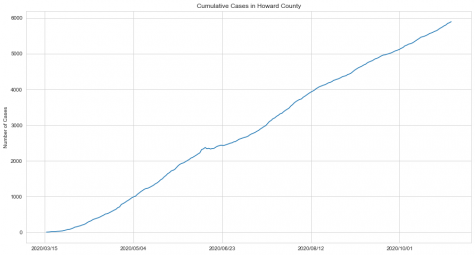How normal is our new norm?
An exploration of online learning
Something about the time we’re in, the online learning, social distancing, and unrest, somehow seems paradoxical. I can remember leaving my last 6th period like it was yesterday: the classroom was arranged as if nothing had changed and we went home like we would any other day. Maybe what is so memorable about it for me was that it was so routine. However, nothing is ordinary about leaving school because of a pandemic.

Now, as we return to class on our laptops, phones, and tablets, we are forced to reckon with the absurdity of it all. Sometimes, as I grow used to the online environment, I snap back into a twisted reality check: while online is the new “normal,” nothing about online school feels normal. The term “in person schooling” even sounds taboo. The situation also doesn’t seem to be moving in a positive direction either, as Governor Hogan recently warned the citizens of Maryland of an impending second wave.
I recently talked to one of my friends, Long Reach senior Grace Jeon, about her experiences in online schooling. It is important to note that Jeon takes the majority of her classes through JumpStart, a program that allows high school students in Howard County to enroll in local community college classes. This also means that Grace only has one class, as opposed to four, with a Long Reach teacher.
We first discussed the pros and cons of online learning. Firstly, in our case, learning from home is comfortable. Being at home 24/7, it’s hard to forget materials you need for class, and daily preparations boil down to waking up and opening your laptop. This aspect of online learning was something that was appreciated in the beginning of online schooling late last school year, with limited classes and a waning school year.
However the situation is give and take: “Class isn’t just to learn, you learn how to be social — you learn your way around the world through school,” she later explained, “…that’s why I’m so worried about younger kids now, [like preschoolers and kindergarteners]” (Jeon is a teaching aid for a Korean language class with children ranging from second to ninth grade).
I have heard similar concerns from another instructor, one who teaches fourth grade: in some cases, children have to sit through seven hours of instruction while managing other home responsibilities such as taking care of younger siblings who have their own classes to attend. While cases vary from person to person, learning remotely can come with a heap of challenges.
Jeon also mentioned a reduction in social interactions. “In a school environment you have more accessibility to your friends,” she described. In a way, Jeon went on to elaborate, she could stay on top of things through peers, whether it be homework or an upcoming test, by way of conversation. Obviously now, things are different: “I am living day to day — I am living due date to due date and it’s horrible,” Jeon mentioned in a half jovial, half genuine tone.
For many of my peers, college applications are amongst our foremost concerns. As seniors, we are in the process of shaping our future, a process which can at times induce some anxiety. Students and even colleges would agree that the situation is not ideal. However, that is not to say that there is nothing to be gleaned from our individual experiences. It will be no doubt that this year, which has brought to light a certain social reckoning, will be on our minds for years to come.
Data retrieved from: https://coronavirus.maryland.gov/

![Photo Courtesy of
A teen faces colorism at school and at home in 'Genesis Begins Again'
[Photograph]. (n.d.). NPR.https://www.npr.org/2019/01/31/690381040/a-teen-faces-colorism-at-school-and-at-home-in-genesis-begins-again
A complex-ion issue: Colorism [Photograph]. (n.d.). The Chronicle. https://hwchronicle.com/55860/features/a-complex-ion-issue-colorism/
The colorism issue [Photograph]. (n.d.). Issuu. https://issuu.com/overachievermagazine/docs/colourism
_issue_om](https://lrhslightningflash.com/wp-content/uploads/2021/06/Colorism-is-alive-475x380.jpg)
![Long Reach Boosters Club. (March 24, 2023 - 11:33pm). [Digital Image]. Long Reach Has Talent Show Spring 2023. Facebook, Retrieved April 17, 2023 from https://www.facebook.com/longreachboosters/posts/pfbid03kN5BKQj5TDefz1rtVZ5fTBBhjwA39UPPd8GctyMgFvY7B4RihH4rY4EqE7xPwikl.](https://lrhslightningflash.com/wp-content/uploads/2023/05/LR-Talent-Show-3-475x316.jpg)


